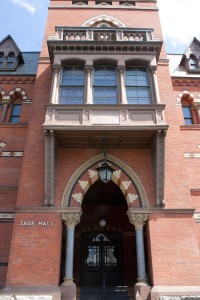The Cornell Historical Society will weigh past vs. present in a discussion panel about renovations to Sage Hall, the first women’s dormitory at Cornell University, which is now home to the Johnson Graduate School of Management, this Saturday.

Presenters at the conference will include Robert Stundtner, project manager of the renovations; Jennifer Cleland, author of the novel “Sage Hall: Experiments in Coeducation and Preservation at Cornell University;” and Alan Chimacoff, principle architect who has worked on the renovations. The underlying question, Chimacoff poses will be how the renovations of Sage Hall further or detract from efforts to preserve the building’s historic symbolism.
The panel was inspired by the self-publication of Cleland’s book, which details the history of coeducation at Cornell University. The book is about the background and development of coeducation as a concept in upstate New York, building off the landmark Seneca Falls Women’s Convention in 1848.
At the time Sage Hall was built, Cornell was declared a coeducational institution, but women had to live downtown. Cleland said it took decades before women and men would say “hello” to each other in the hallways, and women always sat isolated in the front of classrooms. After Sage Hall was built, Chimacoff said, the environment of the residence hall felt like a jail.
“Psychologically, [women] were conditioned to believe they were weaker by the circumstances of the lives that they led,” Chimacoff said. “There was a woman who ran [Sage Hall] who was like a warden, so it was kind of like prison life. The women didn’t like being incarcerated.”
The renovations to Sage Hall were completed in the late ’90s. At the time of the renovations, preservationists opposed the conversion of the building from a residence hall to an academic building. Nevertheless, Chimacoff said, the building was in bad shape and could no longer function as a residence hall because of funding restrictions and because the location was no longer ideal for a residence hall. Had the Johnson School of Management not revitalized it, Sage Hall risked being torn down.
“The building was neglected and derelict,” Chimacoff said. “The only people who would live there were the unsuspecting foreign graduates. Cornell would assign them living corridors in Sage Hall.”
Sunderland said his discussion panel will help locals become familiar with the building’s history and the building’s symbol of coeducation.
“People will learn that the renovation created an opportunity for the history of Sage Hall and its importance, and the history of Cornell, and for women, generally,” he said. “It did, in fact, create an opportunity to talk about this subject.”
Cleland said people will not only leave the discussion panel with historic knowledge, but also will take away a sense of urgency regarding contemporary gender-related concerns. She said she wants audience members to remember that women’s rights were not always a given, and even today society struggles over things like contraception and women in the workplace.
“Somehow the presidential debate has fallen back into issues that I thought were resolved 50 years ago,” she said. “As much as younger women might not realize it is relevant, I think that these are rights that could easily be taken away. We need to be aware it hasn’t always been like this.”
Ezra Cornell IV, member of the Cornell University’s Board of Trustees, will read a letter at the panel penned by his ancestor, Ezra Cornell, the original founder of the university. When the foundations of Sage Hall were laid down, a time capsule was placed in the cornerstone holding cultural artifacts of the day, including a copy of The Ithaca Journal and Cornell’s letter. The letter was about Cornell’s concerns of how the secular nature of the university would lead to its demise. Cornell didn’t keep a copy, and knowledge of what the letter said was not made public until the Sage Hall renovations in the ’90s, when it was uncovered.
Currently, the building is designed with a large atrium in the middle and classrooms branching around it. Sunderland said both the interior and exterior are intricately detailed and rebuilt with the image of the original building in mind, referencing its former exterior architecture.
“[Sage Hall] is just reinterpreted with modern materials.” Sunderland said. “It serves the purpose of perpetuating the story of why Sage Hall was so important and how it came to be. Its current use and configuration will keep it a vibrant, important place on campus for decades to come.”







